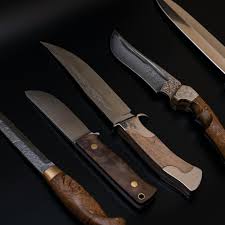Your Cart is Empty
FREE Worldwide Shipping! | +1 365 654 6605
FREE Worldwide Shipping! | +1 365 654 6605
April 12, 2024 4 min read

When it comes to cooking, having the right tools is essential. And one of the most important tools in any kitchen is a good set of knives. But with so many different types and styles to choose from, it can be overwhelming to know which ones you actually need. That's why we've put together this guide to the essential knives every home cook should have.
Let's start with the paring knife. This small but mighty knife is perfect for all those small tasks in the kitchen, like peeling, shaping, and deveining. With a non-serrated edge and a little bit of a slope, the paring knife is ideal for working with your hands. It's not meant for chopping on a cutting board, but rather for precision work. When using a paring knife, it's important to hold it in one place and turn the food into it. This allows for better control and precision. For example, when peeling an apple, you can hold the knife in one hand and turn the apple, making one long peel. The paring knife is also great for coring apples and other fruits, making it a versatile tool in the kitchen. Next up is the chef's knife. This is the workhorse of the kitchen and is a must-have for any home cook. With a blade length of 8 to 10 inches and a curved shape, the chef's knife is perfect for a wide range of tasks, from chopping and dicing to slicing and mincing. When using a chef's knife, it's important to let the knife do the work. You shouldn't have to push down on the knife to make it cut through food. A sharp chef's knife should be able to glide through ingredients with minimal effort. For example, when slicing tomatoes, you can lightly saw back and forth to get a clean slice without squishing the tomato. Another essential knife to have in your kitchen is a serrated knife. This knife is like a mini saw, with teeth on the blade that help cut through foods that are crunchy on the outside and soft in the middle. It's perfect for slicing bread, tomatoes, and other delicate foods. When using a serrated knife, all you need to do is use a gentle sawing motion to cut through the food. The teeth on the blade will do the work for you, giving you clean slices without squishing the food. A serrated knife is a great addition to any kitchen, especially if you enjoy baking or making sandwiches. If you often work with meat or fish, a boning knife is a must-have. This knife has a thin blade and a pointy tip, making it perfect for separating meat from bones with precision and minimal waste. Whether you're deboning a chicken thigh or filleting a fish, a boning knife is an essential tool. When using a boning knife, it's important to be careful and precise. The sharp blade allows you to navigate around bones and separate them from the meat with ease. By using the right technique, you can make clean cuts and minimize any waste. A boning knife is a valuable tool for any home cook who wants to take their meat and fish preparation to the next level. While not technically a knife, a peeler is an essential tool for any kitchen. It makes it easy to remove the skin from fruits and vegetables, saving you time and effort. Whether you're peeling potatoes, carrots, or apples, a good peeler can make the task quick and efficient. When using a peeler, it's important to be cautious and pay attention to your technique. The blade is sharp, and you are cutting towards yourself, so it's essential to use proper hand placement and control. By practicing safe peeling techniques, you can quickly and effortlessly remove the skin from your produce, making meal prep a breeze. To keep your knives in top shape, a honing steel is a must-have tool. While it doesn't actually sharpen your knives, it helps maintain their sharpness by realigning the edge of the blade. Over time, the microscopic serrations on the blade can become bent and twisted, affecting the knife's performance. By running your knife along the honing steel, you can straighten out these serrations and keep your knife sharp for longer. When using a honing steel, it's important to use the correct technique. Hold the steel in your non-dominant hand and place the blade against the steel at a 20-degree angle. Apply light pressure and run the blade along the steel, alternating sides. This process helps maintain the sharpness of your knife and ensures it performs at its best. Having the right knives in your kitchen can make a world of difference in your cooking. From the versatile paring knife to the workhorse chef's knife, each knife has its own unique purpose. By investing in a good set of knives and taking care of them properly, you can enhance your culinary skills and enjoy the process of cooking even more. Remember, these are just the essential knives every home cook should have. Depending on your cooking style and preferences, you may find other knives that are useful for specific tasks. But with the paring knife, chef's knife, serrated knife, boning knife, peeler, and honing steel, you'll have the basics covered. So go ahead and equip your kitchen with these essential tools, and watch your cooking skills soar.The Paring Knife: Small But Mighty
The Chef's Knife: The Workhorse of the Kitchen
The Serrated Knife: For Crusty and Soft
The Boning Knife: Precision and Versatility
The Peeler: Removing Skin with Ease
The Honing Steel: Keeping Your Blades Sharp
Conclusion
References
Be the first to know about upcoming sales and promos. Get a 10% discount coupon when you subscribe!